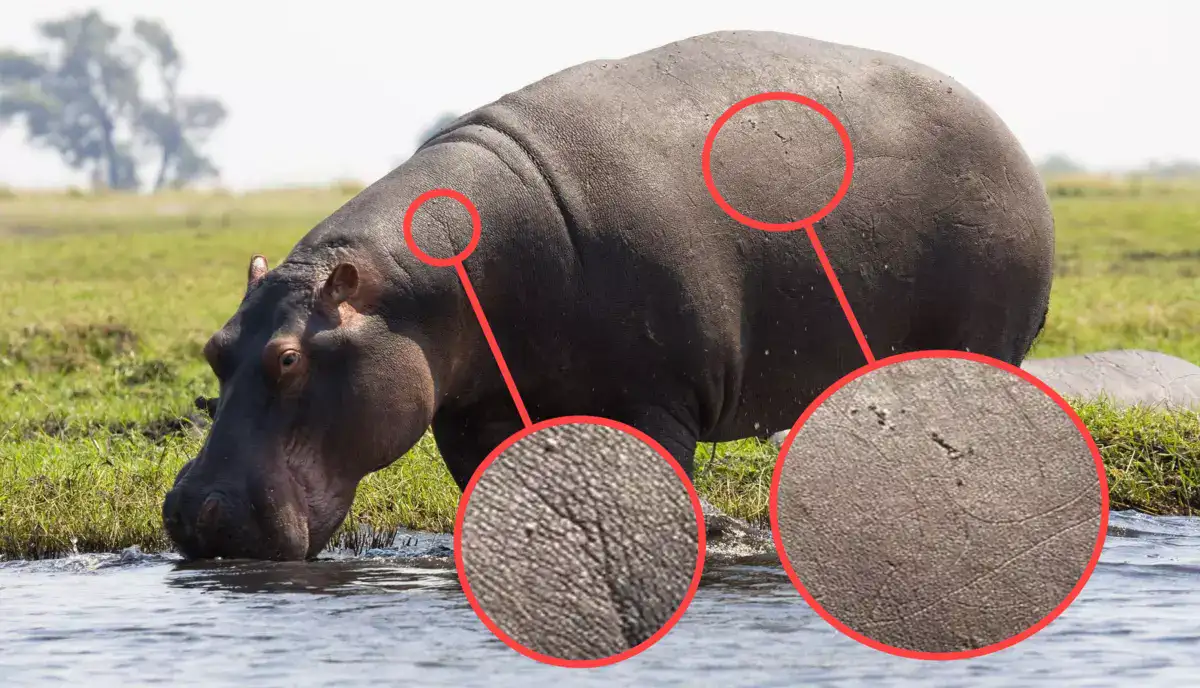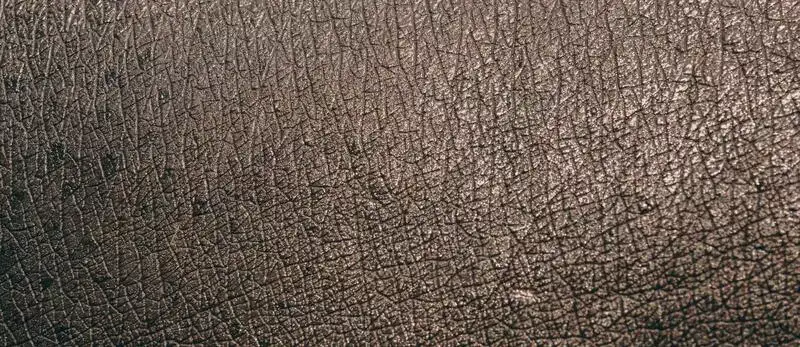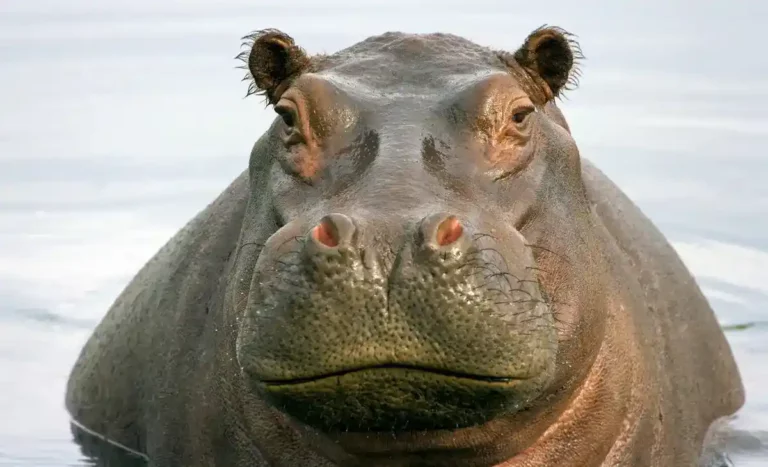
Curious minds have long been fascinated by our planet’s majestic and enigmatic creatures. The hippopotamus stands out as an extraordinary specimen of nature’s ingenuity. These massive and semi-aquatic beasts have captured our imagination for centuries. However, one question still lingers: How thick is their skin?
Hippopotamus’ skin can vary in thickness across different regions of their body. Generally, it measures around 1.5 to 5 centimeters thick. While this may seem insignificant, this unique adaptation plays a vital role in the survival of these extraordinary creatures, safeguarding them from the harsh African sun and fending off potential predators.
How Thick Is Hippo Skin?
Hippo skin is about 2 inches thick on most of its body. This is thicker than the skin of other large megafauna, such as that of elephants (about 2.5 centimeters thick) or rhinos (about two to five centimeters thick).
Hippo skin is also covered in a thin layer of a red substance, sometimes called “blood sweat.” This substance is not blood but does not come from sweat glands. Instead, it is a type of oil produced by the hippo’s skin. This oil helps to protect the hippo’s skin from bacteria and parasites, and it also helps to keep the skin moist.
What Is The Purpose Of A Hippo’s Thick Skin?
The purpose of a hippo’s thick skin is primarily to provide protection. Hippos are known to be highly aggressive and territorial animals, often engaging in aggressive behaviors, especially during mating seasons or when defending their territories.
Their skin protects against potential injuries from bites, scratches, or other confrontations with other hippos or predators. It acts as a natural armor, giving them a significant advantage in survival.
How Does A Hippo’s Skin Differ From Other Mammals Like Elephants And Rhinos?
Compared to other large mammals like elephants and rhinos, hippo skin is unique in its thickness. While elephants have thick skin, a hippo’s skin can be even thicker, reaching up to 2 inches (5 centimeters) in some areas. This makes it one of the thickest skins among land animals.
Rhino skin, on the other hand, is also thick but tends to be less tough than hippos’ skin. Hippo skin’s density and toughness contribute to its effectiveness in protecting the animal from various environmental threats.
Does The Thickness Of A Hippo’s Skin Vary Based On Age Or Gender?
Yes, a hippo’s skin thickness varies based on age and gender. Generally, adult hippos have thicker skin compared to younger ones. Their skin becomes even more robust as they age, developing additional layers that offer better protection. The reason behind this development is the need for increased security as hippos grow older and become more involved in territorial battles.

Regarding gender differences, male hippos typically have thicker skin than females. This difference is again attributed to male hippos’ aggressive behavior and territorial nature. Males are often involved in fierce clashes with other males to establish dominance and secure mating rights. Their thicker skin provides an advantage during such encounters, reducing the risk of severe injuries and ensuring survival.
How Does A Hippo’s Skin Thickness Change Throughout Its Life?
A hippo’s skin thickness changes its life, particularly during the first few weeks after birth. Baby hippos, called calves, have relatively thinner skin than adults. However, their skin rapidly thickens and toughens as they grow and become more independent. This process occurs due to the calf’s exposure to the elements and environment.
As mentioned earlier, adult hippos have the thickest skin, reaching up to 2 inches (5 centimeters) in some areas. This skin thickness develops over time and is crucial to the adult hippo’s ability to survive and thrive in its natural habitat.
What Factors Contribute To The Development Of Thick Skin In Hippos?
Several factors influence the development of thick skin in hippos. One of the primary factors is the hippo’s semi-aquatic lifestyle. Spending a lot of time in water exposes their skin to various elements, such as moisture, sunlight, and microorganisms. This exposure triggers the skin’s adaptation and thickens to protect the hippo from harm.
Additionally, the aggressive behavior and territorial nature of hippos contribute to the evolution of thick skin. Engaging in fights and territorial disputes necessitates a robust defense mechanism, and thick skin acts as a natural defense against injuries during these confrontations.
Furthermore, genetics and evolutionary history are essential in developing thick skin in hippos. Over generations, natural selection favored individuals with thicker skin, ensuring their survival and passing on their genes to the next generation. As a result, hippos today have evolved with thicker skin. This adaptation has proven to be advantageous for their survival.
Can A Hippo’s Skin Be Used For Any Commercial Or Industrial Purposes?
Being incredibly thick and tough, Hippo skin has some potential for commercial and industrial applications. However, it’s essential to emphasize that the hunting and trade of hippos and their products are heavily regulated and, in many cases, illegal due to their vulnerable conservation status.
In the past, hippo skin was occasionally used for certain purposes, such as making whips and other traditional items in some cultures. The leather from hippo skin was highly durable, making it suitable for items that required strength and longevity.
Today, due to conservation efforts and laws protecting hippos from exploitation, using their skin for commercial or industrial purposes is strictly prohibited in most countries. Instead, conservation efforts focus on preserving the species and their natural habitats to ensure the long-term survival of these magnificent creatures.
How Does A Hippo’s Skin Protect It From Sunburn And Harmful UV Rays?
Besides protecting hippos from physical injuries, their thick skin also protects against sunburn and harmful ultraviolet (UV) rays. Spending prolonged periods in water under the hot sun exposes hippos to significant UV radiation, which can damage their skin.
The thick epidermal layer of their skin acts as a natural sunscreen, shielding the underlying tissues from the harmful effects of UV rays. This adaptation is essential for their well-being since sunburn and prolonged exposure to UV radiation could lead to various skin issues and even increase the risk of skin cancer.
Final Thoughts
In conclusion, a hippo’s thick skin is a remarkable adaptation, acting as natural armor, protecting against injuries, sunburn, and UV rays. Thickness varies with age and gender, with adult males having the thickest skin due to territorial behavior. Evolution is influenced by their semi-aquatic lifestyle, genetics, and natural selection.





